Florida Home Inspector George Pembleton, Professional, Certified in Brevard and Indian River Counties in Central Florida

- George Pembleton Home Inspector (321)704-3396
Florida
Home Inspector George Pembleton: "Author"
If you are like most people, chances are you invested a great deal of time in the search for your new home. Whether as a family, a couple or as a single person, you have had a good idea all along of exactly what you wanted your dream home to look like, inside and out. But finding that home has probably been a long and arduous process, most likely taking months, sometimes even years and looking at countless homes, before finally finding
The home for you. Congratulations!
Now comes the time for the real investment, the investment of money and the many years of mortgage payments before your home is finally actually yours and you can celebrate all your hard work and investment of time and money in your home. As you already know, your home is probably going to be the largest single investment of money you will make in your lifetime.
So, now you have finally found your dream home, you've had it inspected or are getting ready to have it inspected, the mortgage is all set up and you are ready to sign that mortgage on the dotted line and take the keys to your brand new dream home.
Not so fast...
Who is Inspecting Your New Home Before You Buy It?
Who did you choose to do your home inspection? This will probably surprise you, but choosing the person that will be inspecting your new home before you buy it, is probably going to end up being one of the most important decisions you will ever make.
Don't let your dream home turn into a nightmare! Make sure you have your home professionally inspected by
George Pembleton of Brevard Florida Home Inspector Services before you buy it, to make sure it is thoroughly inspected by a certified professional that truly cares about the quality of his inspections.
You can easily see how beautiful your home looks from the outside and on the inside. New landscaping, new flooring here, new paint there and that nice new door or countertop all make it look perfect. But the truth is that even a brand new home can have minor to serious problems that can cost you a staggering amount of money to fix in the future... after the damage has been done years later from undetected home construction problems that existed at the time of purchase.

- Home Inspector George Pembleton will save you Money
Trust your home inspections to
George Pembleton (BrevardHomeInspections.com) where our motto is,
"Before you invest, let us inspect!" George has over
12 years of experience in the construction field serving as Project Coordinator, Construction Manager, Assistant Director of Facilities, Regional Director of Construction, and an Electrical Contractor. George is certified by the National Association for Certified Home Inspectors (NACHI).
If you think we are exaggerating the importance of having your home inspected by a fully licensed, certified and highly qualified home inspector, please believe us, we are not. Home inspections are a very serious business before purchasing a new home. Horror stories abound all over, of people that have paid hundreds of thousands of dollars on a home, only to find major issues costing tens and possibly even hundreds of thousands of dollars to fix. These stories happen almost every day.
In fact, there is now a reality television show that just deals with real home inspections. On a recent episode it featured a couple who had spent almost $300,000 on a new home after having it professionally inspected, only to find such serious structural damage shortly afterwards, that it was initially thought they would have to tear the entire home down and rebuild it. Luckily they were able to salvage their home, but only due to the expertise of the inspector and the contractors that took on the challenge.
This is of course a very extreme situation, but serious and almost as serious issues come up all the time after home purchases that were based on inadequate home inspector s. At Brevard Home Inspection Services, we do four main types of home inspections.
Pre-Purchase Home Inspections in Melbourne, Palm Bay, Brevard and Indian River
Our pre-purchase inspections are a complete, visual non-invasive inspection of the home, but not technically exhausting unless issues are found that need a further look. The roof, attic, exterior, foundation, doors and windows, floors, steps, plumbing system, electrical system, heating and A/C system will all be carefully inspected. Also the site will be inspected for proper drainage and any other issues. You will have your inspection report online within 24 hrs. and it will list the deficiencies noted during the inspection, pictures of any deficiencies found, and a recommendation on any needed repairs or further inspections needed.
Wind Mitigation Florida Home Inspector in Brevard and Indian River Counties
Wind Mitigation is a visional inspection roof and basic structure consisting of what building code was used to install the roof covering, roof geometry, roof deck attachment, roof to wall attachment, gable bracing (when applicable), what building code was used to build the structure, wall construction type, whether it has a SWR (secondary water resistance), and opening protection. All openings must be protected by either shutters, high impact windows, and garage door approved by the state of Florida that is impact rated. This type and main reason for this inspection is for the benefit of the home owner to help lower their insurance costs. Most houses qualify for some discount but usually only the houses they have been built within the last few years will qualify for every discount. Without any these improvement the home owner will find his or her insurance extremely high.
Seller's: Florida Home Inspector on Florida's Space Coast
A pre-sale inspection is done to find out if there are any repairs needed prior to putting a home on the market. This inspection report can be made available to all potential home buyers and realtors. We will also install a sign in your front yard to let everyone know your house has been inspected and is "Move in Certified and Ready to Move in".
The are some major advantages to doing this, as follows:
- Any major repairs can be made ahead of time, thus giving the seller time to negotiate a fair cost to make the repairs
- Homes that are in good shape can demand top dollar, even in a down market
- Most people look for a home that is in "move in condition"
- Helps prevent deals from going sour in the eleventh hour when something unexpected is found
- Fifteen copies of the inspecction report are left on site for the potential buyers to review.
- Inspection report uploaded to a secure website so the public can see it online.
4 Point Insurance Home Inspection in Brevard County and Indian River County
We provide fast and accurate 4 Point Insurance Inspection for the insurance industry in Brevard and Indian River Counties. Our 4 Point Insurance Inspections consist of a visual inspection of the condition of the roof, electrical, heating & A/C systems and the plumbing system.
Brevard Home Inspection Services is located in Indian Harbor, FL and is owned and operated by George Pembleton of Brevard Home Inspection. We proudly serve Brevard and Indian River Counties and provide service to home buyers and sellers, investors, real estate attorneys, banks, insurance companies and work with several real estate offices.
Contact Florida Home Inspector
George Pembleton Today @ (321)704-3396 WHEN YOU NEED THE VERY BEST!
International Association of Certified Home Inspectors: 

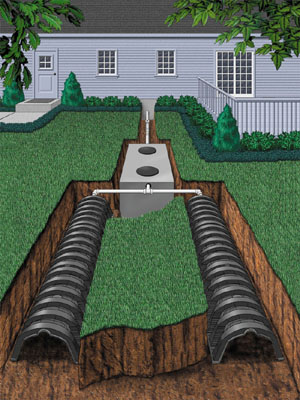



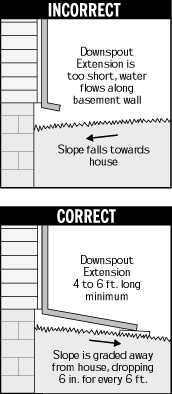
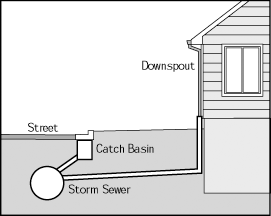 When it rains, your roof sheds a tremendous quantity of water that must be moved away from the foundation to protect the basement or crawl spaces. Gutters, downspouts and downspouts extensions serve this function.
When it rains, your roof sheds a tremendous quantity of water that must be moved away from the foundation to protect the basement or crawl spaces. Gutters, downspouts and downspouts extensions serve this function.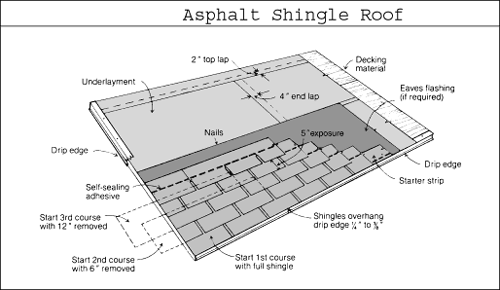
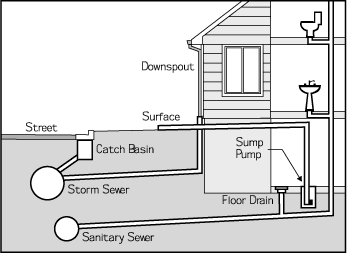
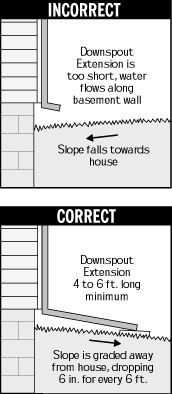 Proper grading around the house is your best protection against seepage into the basement that may cause expensive damage. (See figure on left) . When a home is built, workers dig the excavation several feet larger than the basement walls to allow for construction clearances. At the base of the hole, near the footing, they install a drain tile system and cover it with a small amount of gravel. After they apply a damp-proof coating to the wall, the hole is filled.
Proper grading around the house is your best protection against seepage into the basement that may cause expensive damage. (See figure on left) . When a home is built, workers dig the excavation several feet larger than the basement walls to allow for construction clearances. At the base of the hole, near the footing, they install a drain tile system and cover it with a small amount of gravel. After they apply a damp-proof coating to the wall, the hole is filled.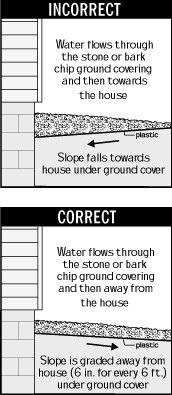 Bushes near the foundation, planted above the original foundation hole, often settle. If there is bare soil under the bushes, just add more soil. However, adding more than a few inches of soil can damage bushes by eliminating air from the roots. Check with a professional landscaper on the potential damage to your type of bushes. You may need to raise the bushes and fill under them.
Bushes near the foundation, planted above the original foundation hole, often settle. If there is bare soil under the bushes, just add more soil. However, adding more than a few inches of soil can damage bushes by eliminating air from the roots. Check with a professional landscaper on the potential damage to your type of bushes. You may need to raise the bushes and fill under them.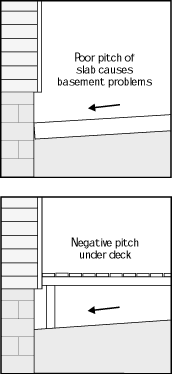 If there is sod next to the foundation, cut it with a sod cutter and fold it away from the foundation. Add soil, then lay the sod back in place. You could add soil directly over the sod, but that would require re-seeding, and the area will settle as the buried sod decomposes. Cover the sod only if it is in very poor condition or if you need a dramatic change in grade.
If there is sod next to the foundation, cut it with a sod cutter and fold it away from the foundation. Add soil, then lay the sod back in place. You could add soil directly over the sod, but that would require re-seeding, and the area will settle as the buried sod decomposes. Cover the sod only if it is in very poor condition or if you need a dramatic change in grade.